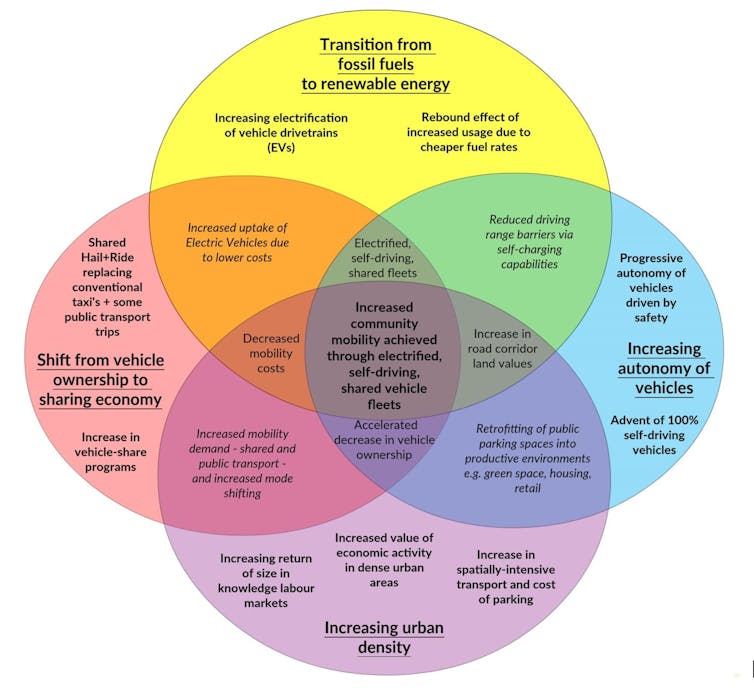Utopia or nightmare? The answer lies in how we embrace self-driving, electric and shared vehicles
- Written by Jake Whitehead, Research Fellow, The University of Queensland
Emerging transport disruptions could lead to a series of nightmare scenarios and poorer transport systems unless we have sensible and informed public policy to avoid this. Of course, some foresee a utopian scene: self-driving electric vehicles zipping around our cities serving all our transport needs without road accidents or exhaust fumes. But the shift to this transport utopia might not be as straightforward as some think.
In a newly published paper, we explore some potential problems linked to vehicle electrification, autonomous vehicles, the sharing economy and the increasing density of cities. We examined what could happen if these four trends are not all properly managed together.
Much has been written about the potential benefits of these disruptions:
electric vehicles powered by renewable energy could cut costs and fossil fuel emissions, and eliminate the significant impacts of pollution on public health and the environment
shared vehicles could reduce transport costs and traffic
autonomous vehicles could eliminate traffic accidents, reduce congestion and increase mobility for everyone
increasing urban density could bring significant economic benefits through growth and efficiency gains when people and businesses are closer together.
However, the interplay between these trends could also result in nightmare scenarios. We developed a Future Mobility Disruption Framework to investigate what could happen if even one of these trends is not actively managed.
 The interactions of transport disruptions need to be anticipated and managed together.
Kane & Whitehead 2018, Australian Planner, Author provided
The interactions of transport disruptions need to be anticipated and managed together.
Kane & Whitehead 2018, Australian Planner, Author provided
Four nightmare scenarios
Our research identified four potential nightmare scenarios.
Nightmare 1: vehicle electrification + autonomous vehicles + increasing urban density
If policy fails to support and manage a shift away from private vehicle ownership towards car-sharing, several negative impacts are likely. In this scenario, electric cars will be cheaper to run and still privately owned. This could encourage more people to drive and create more traffic.
The convenience of self-driving cars with low operating costs might also encourage a shift away from traditional public transport and could even cause its collapse.
Nightmare 2: autonomous vehicles + increasing urban density + shift towards sharing economy
If people shift from private car ownership towards shared, autonomous vehicles, significant transport cost savings could be possible. By replacing public transport systems, shared vehicle services could arguably provide cheap transport for all.
While these benefits are obvious, without vehicle electrification, the use of fossil fuels would significantly increase emissions. Though a reduction in emissions is plausible with a shift away from private vehicle ownership, the low cost and convenience of shared vehicles could lead to higher demand and more trips, thus increasing emissions. This pollution would increase rates of premature deaths and diseases in our cities, and worsen the impacts of climate change.
Nightmare 3: increasing urban density + shift towards sharing economy + vehicle electrification
We would again see a shift away from private vehicle ownership towards shared, electric vehicles. This would reduce transport and pollution-related health costs However, in this scenario, the vehicles would not be autonomous.
The shared vehicle fleet would require human drivers. This would result in higher costs, less efficiency and more accidents. Ultimately, this would be a barrier to the long-term sustainability and widespread use of shared vehicles.
Nightmare 4: shift towards sharing economy + vehicle electrification + autonomous vehicles
So what would happen in the face of three of the transport disruptions occurring without increasing urban density? Electric and autonomous vehicles would significantly reduce transport costs. Combined with the availability of shared services, this would lead to a substantial shift away from private vehicle ownership towards shared, electric, autonomous vehicles (SEAVs).
These vehicles would be efficient, safe and convenient, with minimal environmental impacts. At first this would seem like the ideal scenario to aim for. However, it ignores the potential impacts on urban form and density.
Without policies supporting urban density and public transport, a shift towards SEAVs would probably encourage sprawling, car-dominated cities as people would have fewer reasons to live close to work. SEAVs would be cheap and convenient. They could pick people up from their front door and drop them directly at their destination. People would likely not be as concerned with road congestion as they could carry out other activities during the trip – even working during the drive.
If people feel less restricted in where they choose to live, they might opt for larger houses and lots, further away from cities. This would not only place additional demands on infrastructure but also have a significant impact on the natural environments surrounding our cities.
This form of lower-density living would discourage active transport options, like walking and cycling, which would have negative health impacts. Urban sprawl could also have negative economic impacts as people and businesses spread out and lose the benefits of being close together.
Managing disruptions as a whole
Each of these four trends could independently yield many benefits. However, examination of these nightmare scenarios reveals that, without holistic planning and policy support for all four disruptions, negative unintended consequences are likely. Planners and policymakers must consider how these disruptions will interact.
As detailed in our paper, a range of possible policy interventions is available for managing the risks associated with these trends. These include reform of road taxation, supportive regulation and integrated planning.
Only a holistic approach to managing these disruptions will enable us to arrive at a future transport utopia.
You can read more about these transport disruptions in a forthcoming book, Three Revolutions.
Authors: Jake Whitehead, Research Fellow, The University of Queensland




